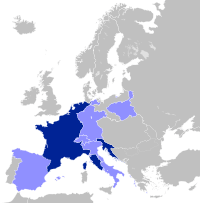Grand Duchy of Berg
| Grand Duchy of Berg | ||||||||||
| Grand-duché de Berg (fr) Großherzogtum Berg (de) | ||||||||||
| Client state of the French Empire | ||||||||||
| ||||||||||
| ||||||||||
.svg.png) The Grand Duchy of Berg in 1812. | ||||||||||
| Capital | Düsseldorf | |||||||||
| Languages | German, French | |||||||||
| Religion | Protestant, Catholic | |||||||||
| Government | Constitutional monarchy | |||||||||
| Grand Duke | ||||||||||
| • | 1806–1808 | Joachim I | ||||||||
| • | 1808–1809 | Napoléon Bonaparte | ||||||||
| • | 1809–1813 | Louis I | ||||||||
| Historical era | Napoleonic Wars | |||||||||
| • | Established | 15 March 1806 | ||||||||
| • | Disestablished | 1 December 1813 | ||||||||
| ||||||||||
The Grand Duchy of Berg (German: Großherzogtum Berg) was established by Napoleon Bonaparte after his victory at the 1805 Battle of Austerlitz on territories between the French Empire at the Rhine river and the German Kingdom of Westphalia.
History
The French annexation of the Duchy of Jülich (French: Juliers) during the French revolutionary wars in 1794 had again separated the two duchies of Jülich and Berg, which since 1614 had both been ruled in personal union by the Wittelsbach dukes of Palatinate-Neuburg. In 1803 the heir of Palatinate-Neuburg, the Bavarian elector Maximilian Joseph, separated the remaining Duchy of Berg from his other Bavarian territories and granted it to his cousin William of Palatinate-Zweibrücken-Birkenfeld-Gelnhausen as administrator, whereby it came under the rule of a junior branch of the Wittelsbachs.

In 1806, in the reorganization of Germany occasioned by the dissolution of the Holy Roman Empire of the German Nation, Maximilian I Joseph, now King of Bavaria, ceded Berg to Napoleon in return for the Principality of Ansbach. On 15 March 1806 the French Emperor put Berg under the rule of his brother-in-law Joachim Murat, including territories of the former Prussian Duchy of Cleves east of the Rhine river. Murat's arms combined the red lion of Berg with the Cleves arms. The anchor and the batons came to the party due to Murat's position as Grand Admiral and as Marshal of the Empire. As the husband of Napoleon's sister, he also had the right to use the imperial eagle. On 12 July 1806 Murat joined the Confederation of the Rhine and assumed the title of a grand duke. His lands, were further enlarged by the annexation of the County of Mark, the Prince-Bishopric of Münster, the Imperial city of Dortmund and numerous minor territories of the Lower Rhenish-Westphalian Circle.
Upon Murat's promotion to the King of Naples in 1808, Berg was at first directly ruled by Napoleon in personal union. In the next year he appointed his infant nephew, Prince Napoleon Louis Bonaparte (1804–1831), the elder son of Napoleon's brother Louis Bonaparte, King of Holland, Grand Duke of Berg; French bureaucrats under Pierre Louis Roederer administered the territory in his name. For nine days in July 1810, Grand Duke Napoleon Louis also ruled over the Kingdom of Holland in personal union.
The economic decline due to Napoleon's failed Continental System led to a series of revolts and uprisings. The Grand Duchy's short existence came to an end, when the French forces pulled back in the course of the 1813 Battle of Leipzig. The territory was then administrated by Prussia, which officially incorporated the former Grand Duchy according to the Final Act of the 1815 Congress of Vienna. Berg became part of the Province of Jülich-Cleves-Berg, the eastern territories of Münster and Mark were merged into the Province of Westphalia.
Coat of arms
.svg.png) Coat of arms of the Grand Duchy of Berg (1806–1809).
Coat of arms of the Grand Duchy of Berg (1806–1809). Coat of arms of the Grand Duchy of Berg (1809–1813).
Coat of arms of the Grand Duchy of Berg (1809–1813).
Departments
References
- Otto von Pivka, Michael P. Roffe, Napoleon's German Allies: Westfalia and Kleve-Berg, p. 3; Google Books
External links
![]() Media related to Duchy of Berg at Wikimedia Commons
Media related to Duchy of Berg at Wikimedia Commons
.svg.png)

